Port of Copenhagen
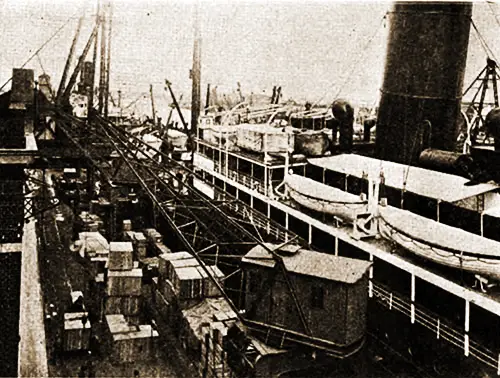
Scene in the Copenhagen Free Harbor, home port of the United Steamship Company's Scandinavian-American liners circa 1921. | GGA Image ID # 1433e791c4
Situated on the highway of traffic from the Atlantic to the Baltic, Copenhagen is the foremost port of transshipment for the trade from America to the Baltic countries and the home port of the Scandinavian-American Line.
The Free Port of Copenhagen (1922)
Advantages of the free port of Copenhagen to American shippers are pointed out in a pamphlet, which has been issued by the Copenhagen Free Port Company, Ltd. Particular attention Is paid to the service which the port affords to American trade with the Baltic countries.
Situated on the highway of traffic from the Atlantic to the Baltic, Copenhagen is the foremost port of transshipment for the trade from America to the Baltic countries, and the home port of the Scandinavian-American Line.
The day is already in sight when American goods will be carried for the most part in American bottoms, and when that happens it is a safe prediction that the Stars and Stripes will seldom be missing from the harbor of Copenhagen.
When a ship is bound for the Baltic with 700 tons of goods for Libau, 1.200 tons for Danzig, 300 tons for Petrograd, 800 tons for Helsingfors and 1,000 tons for Stockholm, it does not pay to go unloaded from one port to another.
A port of transshipment Is needed, and Copenhagen, with its free port—the terminus and port of call of numerous steamship lines and In constant communication with all countries bordering on the Baltic—seems to meet all requirements.
The chief advantage of the Copenhagen free port is Its freedom from any customs duties,'* the pamphlet stales. Merchandise of all kinds is landed, stored, manufactured sad transshipped to other parts of the world without a single penny being paid in customs or other dues to the Danish exchequer.
Thanks to the Ideal construction and contrivances of the warehouses and the extensive use of the most up-to-date machinery and mechanical devices, unloading and transshipment of cargoes are accomplished in a minimum of time, thus making the Copenhagen free port not only the cheapest but also the quickest port of call In the north of Europe.
The port is easily accessible; it is pointed out in the pamphlet, with a direct entrance from the sound, and because of the total absence of tides is navigable at all times.
Good railway facilities link up ail quays and warehouses, connecting with the Danish State railways. Warehouses, free electric power and electric cranes are provided.
The Copenhagen free port can be used In two ways, according to the pamphlet. The merchant or manufacturer desirous of shipping goods through the free port may either arrange with one of the steamship companies to have his goods shipped to the port of destination on through bill of lading or shipped to the free port on option bill of lading, deferring settlement of the final destination of the goods until after their arrival at the Copenhagen free port, or the exporter may forward his goods direct to the free port for storing in the company’s warehouses, and from there have them transshipped to other ports or directed into Denmark.
Transit goods are warehoused by the company free of charge for about a fortnight. For those wishing to forward goods for storing in the Tree port for transshipment later on it is, however, necessary to have a representative in Copenhagen or employ a local firm of forwarding agents, as the Free Port Company does not undertake forwarding business, but merely executes orders given by the shippers to their representatives or forwarding agents.
Copenhagen (København) is the capital of Denmark and situated on the eastern coast of Zealand and stretches across part of Amager. Located on the highway of traffic from the Atlantic to the Baltic, Copenhagen is the principal port of transshipment for trade from America to the Baltic countries and the home port of the Scandinavian-American Line.
From 1886, the west rampart (Vestvolden) was flattened, allowing major extensions to the harbor leading to the establishment of the Freeport of Copenhagen 1892–94.
The spread of housing to areas outside the old ramparts brought about a considerable increase in the population. In 1840, Copenhagen was inhabited by approximately 120,000 people. By 1901, it had some 400,000 inhabitants. Electricity came in 1892, with electric trams in 1897.
As a result of Denmark's neutrality in the First World War, Copenhagen prospered in trade with both Britain and Germany. At the same time, the city's defenses were kept fully manned by some 40,000 soldiers for the duration of the war.
By the beginning of the 20th century, Copenhagen had become a thriving industrial and administrative city. Its new city hall and railway station drew its center towards the west.
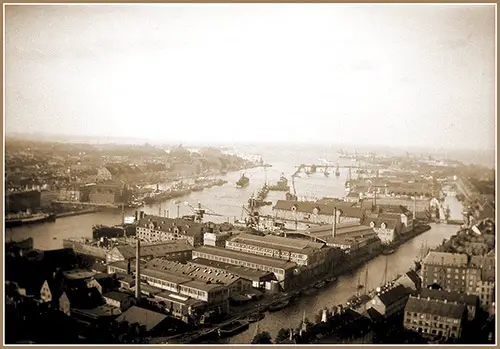
View of the Harbor of Copenhagen, Denmark, circa 1930. | GGA Image ID # 1d47120f53
Copenhagen is the natural entry port for the eastern part of the Baltic and the Gulf of Bothnia, with several large and many small, but all relatively prosperous, cities along the coasts of northern Germany, the Russian Baltic provinces, Finland, and Sweden.
All the cities in the neighborhood have large hinterlands that produce significant quantities of merchandise and need facilities for import and export. Copenhagen has all the necessary qualifications to make a free port successful.
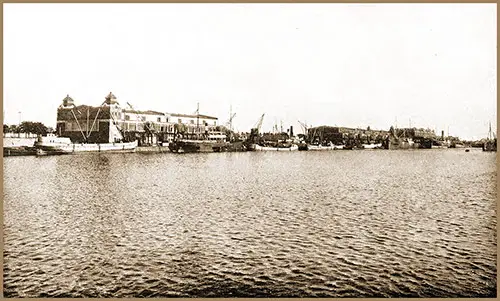
Port of Copenhagen East Basin Seen from the North. The Copenhagen Free Port, 1923. | GGA Image ID # 1d47d5e8df
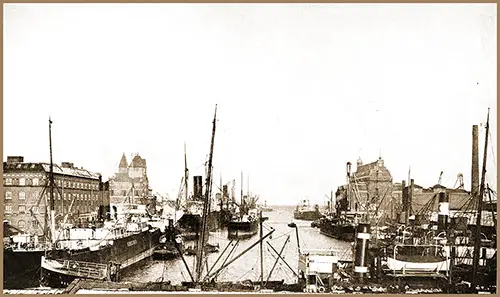
The Port of Copenhagen West Basin Seen from the South. The Copenhagen Free Port, 1923. | GGA Image ID # 1d47da3081
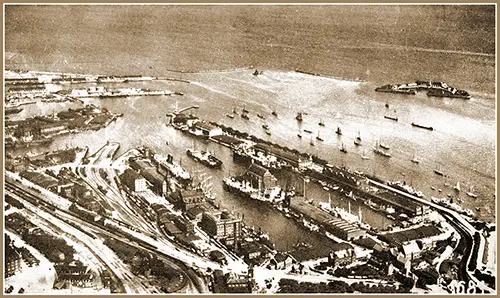
Bird-Eye View of the Free Port of Copenhagen, 1923. | GGA Image ID # 1d47f97ac9
A free port is one where merchandise can be discharged and exported without paying customs duty. A free port is, therefore, a part of the country in which it is located outside its customs limits.
One of its advantages is the same offered by what we call here a bonded warehouse, viz., that one can take the goods into the storehouses without paying duty unless they are retaken out of the storehouses into the country.
The free port offers greater advantages than the bonded warehouse because it allows for the erection of factories, where one can make the imported goods into finished articles.
For instance, it is possible to import certain goods from North America and others from South America or the Indies, using some of the country's products, and to make one finished product out of these different articles.
In the United States, we have a "drawback." which means repayment of duty paid on goods imported and re-exported. For instance, there is a drawback to the Canadian wheat that enters our flour. Still, a disadvantage is always a rather tricky thing to control. It is much easier to have a place outside the customs limits where manufacturing can be done.
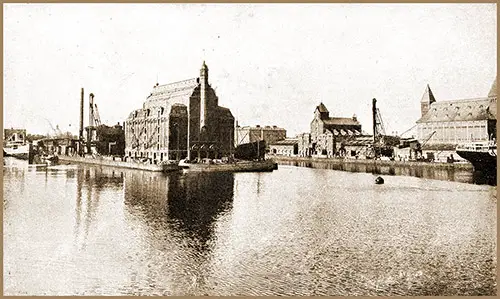
The Port of Copenhagen Central Pier and West Quey Seen from the North. Older Silo Warehouse in the Center. Drapery Warehouse, Watehouse A and New Silo Warehouse to the Right. Depth of Water, 9.1 Meters or 30 Feet. The Copehagen Free Port, 1923. | GGA Image ID # 1d485e55f8
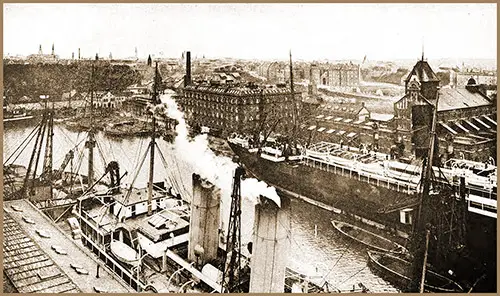
Partial View of the West Basin with Drapery Warehouse in the Center. Copenhagen is in the Background. The Copenhagen Free Port, 1923. | GGA Image ID # 1d486a1e7b
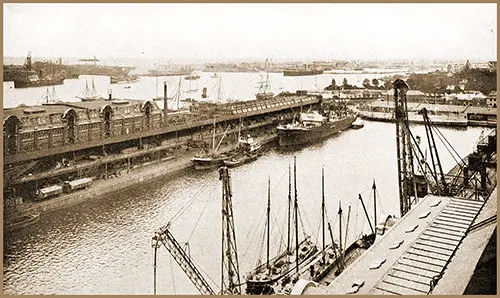
Port of Copenhagen East Basin Seen from the North. To the Left, Warehouse I and Shet I. To the Right, Older Silo Warehouse and Grain Discharge Appliances. Depth of Water, 9.1 Meters or 30 Feet. The Copenhagen Free Port, 1923. | GGA Image ID # 1d4882b201
So that a free port shall thrive, it must have access to the sea for large vessels and must have a big area over which it can distribute the goods. These qualifications, however, are necessary for any big harbor. The third and most important condition for a free port is that the exportation district is under other custom domination.
I would, for instance, consider that New York has not had all the qualifications for becoming a great free port because a comparatively small part of the goods arriving at New York from overseas is destined to be distributed to countries outside the custom sphere of the United States.
Copenhagen has one more advantage, which is not necessary but very desirable. I have pointed out above: the water lanes leading up to it are so deep that they can take in a giant ship, while the lanes leading from it are more shallow.
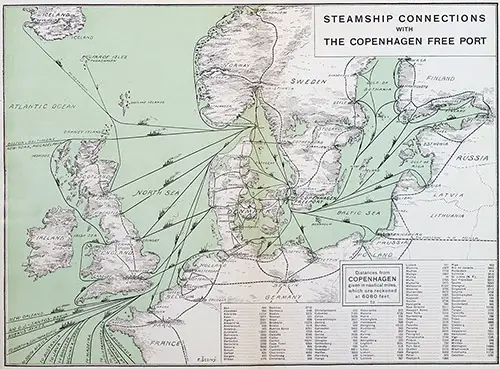
Map of the Steamship Connections with The Copenhagen Free Port, 1923. | GGA Image ID # 1d4915d93e
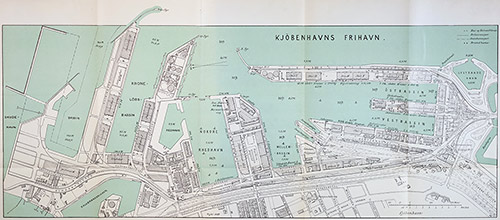
Map of the Free Port of Copenhagen, 1923. | GGA Image ID # 1d49649332
Bibliography
"The Free Port of Copenhagen," in Shipping: Marine Transportation, Construction, Equipment and Supplies, New York: Shipping Publishing Co, Volume 15, No. 4, February 25, 1922 p.40
Georg Becch, "The Free Port of Copenhagen," in The American Scandinavian Review, Vol. VII, No. 3, May-June 1919, pp. 184-189.
